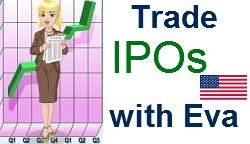Coty, the beauty-products conglomerate behind Calvin Klein perfume, Sally Hansen nail polish and Lady Gaga fragrance will price its initial public offering late Wednesday, marking its long-awaited market debut following delays last year.
The deal could raise up to $1.22 billion, including the possible sale of extra shares to underwriters. That would make it the largest U.S.-listed IPO ever for a consumer-products company, according to Dealogic.
If the offering proves a success, some of the credit will go to a U.S. IPO market that has been on a tear of late, investors say.
U.S.-listed companies and their financial backers have sold $19.6 billion in stock this year, putting the IPO market on track for one of its biggest years since the financial crisis, according to Dealogic. Just 25% of this year’s deals have priced below companies’ expectations, the lowest since 2009.
Some analysts have been lukewarm on the Coty deal. Coty is expected to fetch a price relative to its earnings that exceeds those of some other perfume and cosmetics makers. Much of Coty’s revenue comes from Europe, which remains mired in a recession, and some recent acquisitions haven’t panned out as well as hoped.
What’s more, the cash raised from the deal won’t help the company expand—all shares are being sold by owners including Joh. A. Benckiser GmbH, or JAB, which manages the investments of one of Germany’s wealthiest families, the Reimanns. Following the IPO, JAB and two other Coty owners, Berkshire Partners and Rhone Capital, will control 97.7% of the company’s voting rights.
Coty’s “valuation does not seem overly attractive,” given the company’s business mix and relatively slow sales, B. Riley & Co. analyst Linda Bolton Weiser wrote in a note to clients this week. Ms. Weiser rates the shares “neutral” and assigned them a price target of $19.
A spokesman for Coty and JAB declined to comment.
Still, people familiar with the deal say they expect Coty to price at least in line with the company’s expected range of $16.50 to $18.50 a share. At the midpoint of that range, Coty’s market value would be about $6.9 billion, according to IPO research firm Renaissance Capital.
Coty, founded in Paris in 1904, has some characteristics that have been in short supply during this year’s IPO renaissance. It would be the first consumer-products company to go public in the U.S. this year.
This year has had just one U.S. retail IPO, that of grocery-store operator Fairway Group Holdings Corp., according to Dealogic. A much greater share of the activity has come from real-estate investment trusts, with stable cash flows and high dividend payouts that have appealed to stock investors’ defensive posture and thirst for income at the start of the year.
“Consumer IPOs are a proxy for investors’ belief in rising consumer confidence,” said Michael Bauer, managing director of equity capital markets at Jefferies Group LLC, a subsidiary of Leucadia National Corp., which isn’t involved in the IPO. At the same time, he said, “there is a scarcity of high-growth consumer names.”
Coty is coming to market ahead of several other consumer IPOs in the pipeline. Organizational-housewares retailer Container Store Inc. has hired banks to pursue a potential IPO, according to people familiar with the move. Last month, Claire’s Inc., the teen-accessories chain backed by private-equity firm Apollo Global Management LLC, filed initial paperwork for an IPO, as did casual restaurant chain Noodles & Co.
If the deal prices at the high end of expectations, the company’s share price would equal about 21.6 times Coty’s expected 2013 earnings, according to people briefed on the deal. Companies’ valuations in IPOs are typically lower than already-public peers, to entice investors to a stock not yet market-tested.
Estee Lauder Cos. trades at 26 times analysts’ expectations for its 2013 earnings, according to FactSet. Avon Products Inc. trades at 20 times this year’s expected earnings, while Elizabeth Arden Inc. trades at 20, according to FactSet.
Another concern is Coty’s exposure to economically troubled parts of Europe. Weakness in demand in such areas weighed on recent sales of some of the company’s top fragrance brands, such as Adidas, Calvin Klein and Davidoff, according to regulatory filings. Coty’s revenue from Europe, the Middle East and Africa fell 3.1% in the nine months ended March 31. The region accounted for about 47% of total revenue. Coty generated $4.6 billion in revenue in its latest fiscal year, ended June 30, 2012.
Additionally, the offering is set to convert Coty’s current holders’ ownership into Class B shares conveying outsized voting rights. The structure will give the insiders a greater-than-usual amount of say, versus public shareholders, in some of the company’s future affairs.
On the plus side, Coty expects demand from a rising middle class in developing countries to aid its bottom line. The company is targeting generating more than one-third of its revenue in emerging markets five years from now, versus 23% in its 2012 fiscal year, according to regulatory filings.
“They’re in a great industry with a good product portfolio, a pretty good track record with acquisitions and a good management team,” said Laura Starr, senior research associate at Nuveen Asset Management, which runs more than $120 billion in assets. “In the near-term though, their business has slowed down a little. Some of it’s due to Europe being slow and some of it’s due to the recent acquisitions.”
As late as Tuesday, Ms. Starr and other analysts at Nuveen were still debating whether to buy shares in the IPO, she said. The prospects for beauty-products maker in the developing world are part of why Nuveen holds Coty peer Estee Lauder Inc. in its Large Cap Growth Opportunities Fund, she added.
Coty’s shares are expected to start trading Thursday on the New York Stock Exchange under the symbol COTY. Bank of America Corp. is leading the deal with J.P. Morgan Chase & Co. and Morgan Stanley.











































